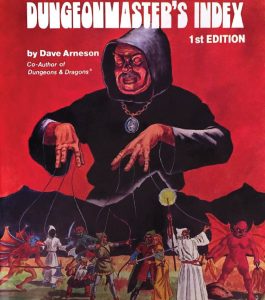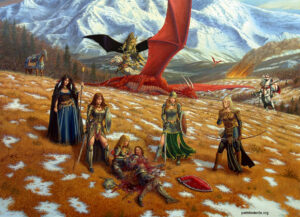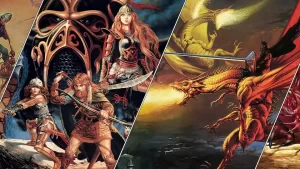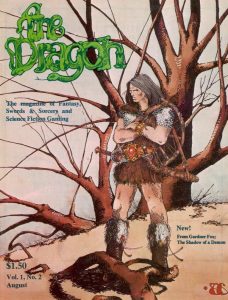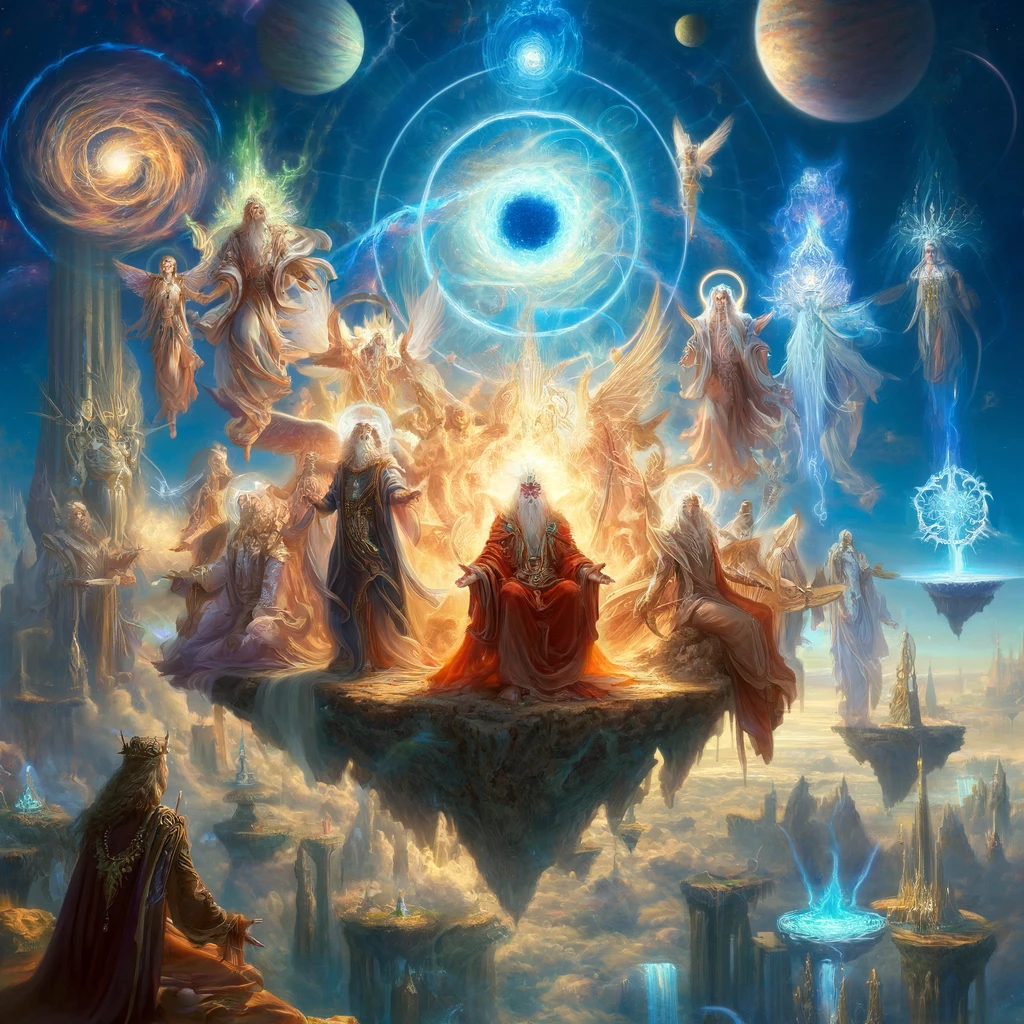
This robust framework enriches high-level play, allowing characters to transcend their mortal limits and engage in epic adventures across various RPG systems. For those interested in delving deeper, the full Immortal Rules PDF is available at the end of this article.
The Dawn of Immortality
The twilight sky shimmers with celestial light as your character ascends to a state few mortals can fathom. The journey from humble beginnings, through trials and triumphs, culminates in a singular moment of transcendence. The power of the Celestial voice resonates in your ears, heralding a new chapter in your character's epic saga. "You have succeeded!" The words echo, not just in the air, but in the very fabric of your being. You have achieved Immortality, breaking free from the mortal coil and stepping into a realm of boundless potential and unfathomable power.
Immortality in Dungeons & Dragons is not merely a prolongation of life; it is a metamorphosis into a being of pure essence. As an Immortal, your character's spirit and body are transformed into a conduit of divine power, capable of feats beyond mortal comprehension. The homeworld you once knew dwindles to a distant memory, a mere speck against the vast backdrop of the multiverse. You stand at the precipice of infinite possibilities, where every decision reverberates across dimensions and echoes through time.
In this exalted state, the rules of existence themselves bend to your will. Experience Points (XP) accumulated in your mortal journey are converted into Power Points (PP), the currency of Immortal power. These points are the lifeblood of your new abilities, enabling you to manipulate reality, create new forms, and wield cosmic energies. With each 10,000 XP equating to 1 PP, a typical starting Immortal has between 300 and 500 PP, marking the beginning of a journey that promises even greater power.
The Transformation of Form
Immortality bestows upon you the ability to assume multiple forms, each tailored to specific needs and desires. You can exist as pure incorporeal energy, immune to most physical attacks but limited in actions. Alternatively, you can manifest in a durable, material form, designed for convenience and combat. When revisiting the Prime Plane, you may choose your original mortal form, replete with all its familiar traits and flaws, but enhanced by your Immortal essence.
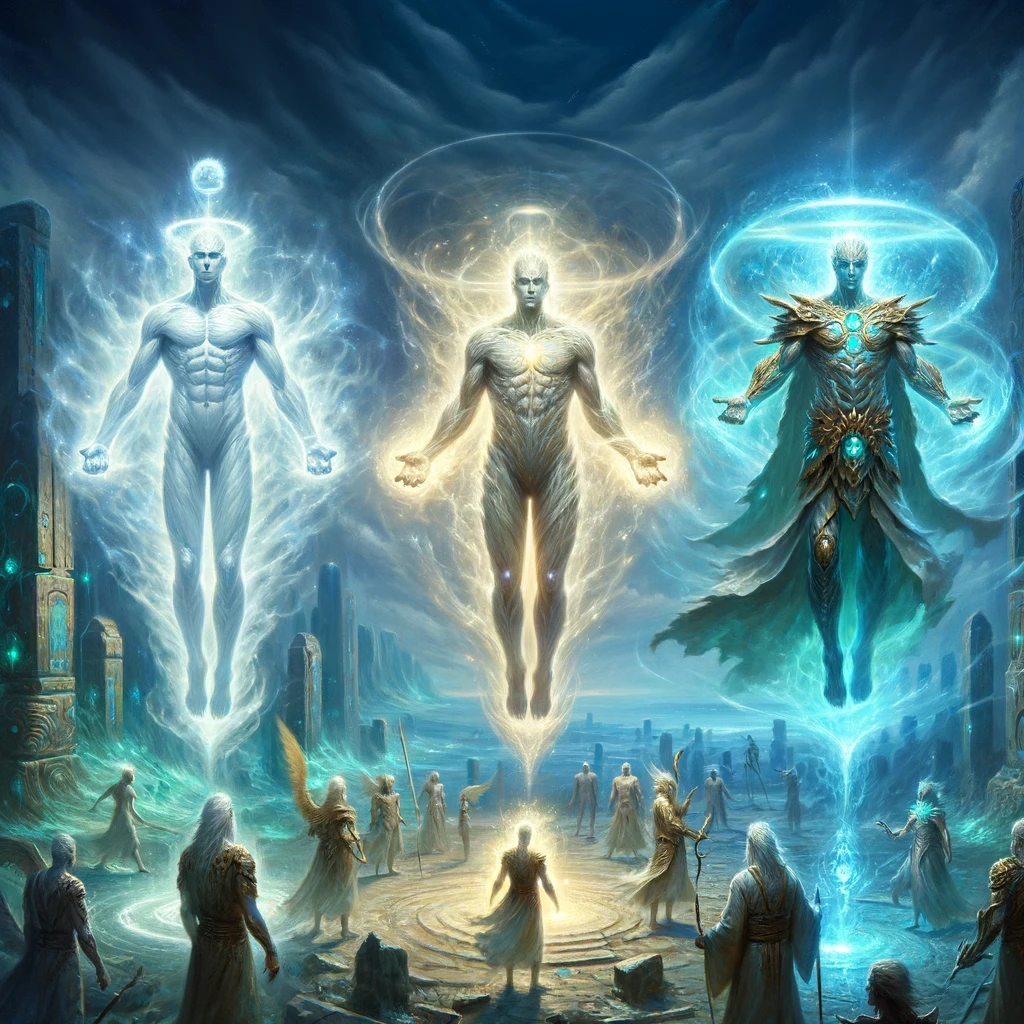
The Spheres of Power
Immortals are bound to one of five Spheres of Power, each representing a fundamental aspect of existence: Matter, Energy, Time, Thought, and Entropy. Your allegiance to a Sphere shapes your abilities and your role in the cosmic order. Whether you serve Matter, resisting the ravages of Time and Energy, or Thought, imposing order on chaos, your Sphere defines your purpose and your path.
The Majesty of Immortal Abilities
As an Immortal, your senses extend beyond the mortal realm. You perceive sound and light in all their forms, communicate through Aura, and manipulate physical reality with unparalleled precision. Your Aura, a manifestation of your divine presence, can inspire awe or terror in mortals, bending their will to yours. Your Anti-Magic field provides a bulwark against magical attacks, reflecting your supreme control over the arcane.
Combat as an Immortal transcends the physical. Your attacks can directly target the essence of your foes, draining their Power Points or diminishing their abilities. You engage in battles that span planes and dimensions, where the very fabric of reality can be your weapon or your shield. The order of combat is intricate, reflecting the complex interplay of Immortal powers and mortal resistance.
The Eternal Quest
Immortality is not the end of your character's journey but a new beginning. The quest for power continues, driven by the need to amass more PP, enhance abilities, and ascend through the ranks of Immortals. From Initiate to Temporal, Celestial to Empyreal, and beyond, each rank brings new challenges and greater responsibilities. Your character's ultimate fate lies in your hands, a testament to your skill, strategy, and imagination.
The beauty of adventuring as an Immortal in Dungeons & Dragons lies in the endless horizons it unveils. Your character's story is woven into the grand tapestry of the multiverse, where every action has cosmic significance. The thrill of discovery, the allure of ultimate power, and the profound responsibility of Immortality create a narrative rich with intrigue and wonder.
In the realms of Immortality, your character is no longer bound by the mundane. You are a shaper of worlds, a master of destinies, and a beacon of limitless potential. As you navigate this new existence, remember that the true essence of Immortality is not just power, but the wisdom to wield it. Embrace the infinite, and let your adventures as an Immortal be a testament to the timeless beauty of Dungeons & Dragons.

Key Points and Sections
The rules in the Immortal Set are designed for high-level play in a fantasy role-playing game, specifically for characters who have achieved Immortal status. Here are some key points and sections:
- Transition to Immortality:
- Your character achieves Immortality, gaining new powers and responsibilities.
- The game shifts focus from mortal concerns to the vast possibilities and powers of an Immortal.
- Character Changes:
- Experience Points (XP) are converted to Power Points (PP), which are used to perform various actions.
- Immortal characters have different forms and abilities that surpass those of mortals.
- New Abilities and Mechanics:
- Immortals have several new abilities and stats, such as Aura, Anti-Magic, and various forms of movement (Universal, Interplanar, Interdimensional).
- There are different Spheres of Power that Immortals can belong to, each with specific characteristics and favored classes.
- Combat and Interaction:
- Immortal combat involves more than just physical attacks. There are new attack forms like Aura and Power attacks.
- Combat order and mechanics are detailed, including how to handle multiple forms of attack and defense.
Analysis of Specific Rules
- Power Points (PP):
- Conversion and Use: XP is converted to PP at a rate of 10,000 XP to 1 PP. PP are used for various actions, such as creating effects, enhancing abilities, and combat.
- Regeneration: PP regenerate based on the plane's bias towards the Immortal. Friendly planes regenerate PP faster than hostile ones.
- Forms and Abilities:
- Material and Incorporeal Forms: Immortals can exist in multiple forms, including incorporeal (without matter) and material forms designed for specific functions.
- Ability Scores: Immortal characters retain their ability scores but can enhance them by expending PP.
- Combat Mechanics:
- Aura: Immortals can use their Aura to inspire awe or terror in mortals, affecting their reactions and potentially immobilizing them.
- Saving Throws: Immortals have new saving throws for different types of attacks, such as Power Drain and Physical Blow.
- Spheres of Power:
- Immortals serve one of the five Spheres: Matter, Energy, Time, Thought, and Entropy (NPC only).
- Each Sphere has its own favored classes, elements, and purposes, affecting how Immortals interact with the multiverse.
Points of Clarity
- Power Points and Their Use: The conversion of XP to PP and their role in gameplay is well-defined, making the transition from mortal to Immortal clear and manageable.
- Forms and Abilities: The flexibility in forms and the enhancement of abilities give players creative freedom while maintaining a structure for gameplay.
- Combat and Interaction: The addition of new combat mechanics, such as Aura and Power attacks, adds depth to interactions and conflicts, fitting for the elevated status of Immortal characters.
- Spheres of Power: The division into Spheres adds an interesting layer of allegiance and strategy, influencing how Immortals approach their goals and interact with the multiverse.
Adapting and Use Any RPG System
The Immortal Set from the Dungeons & Dragons Immortals Rules Box Set provides a robust framework that can indeed be adapted and applied to various tabletop RPG systems such as Pathfinder 2e, D&D 2e, D&D 5e, AD&D and others. While each system has its unique mechanics and flavor, the core concepts of the Immortal Set can enrich any campaign by introducing high-level play and the concept of characters transcending their mortal limits.
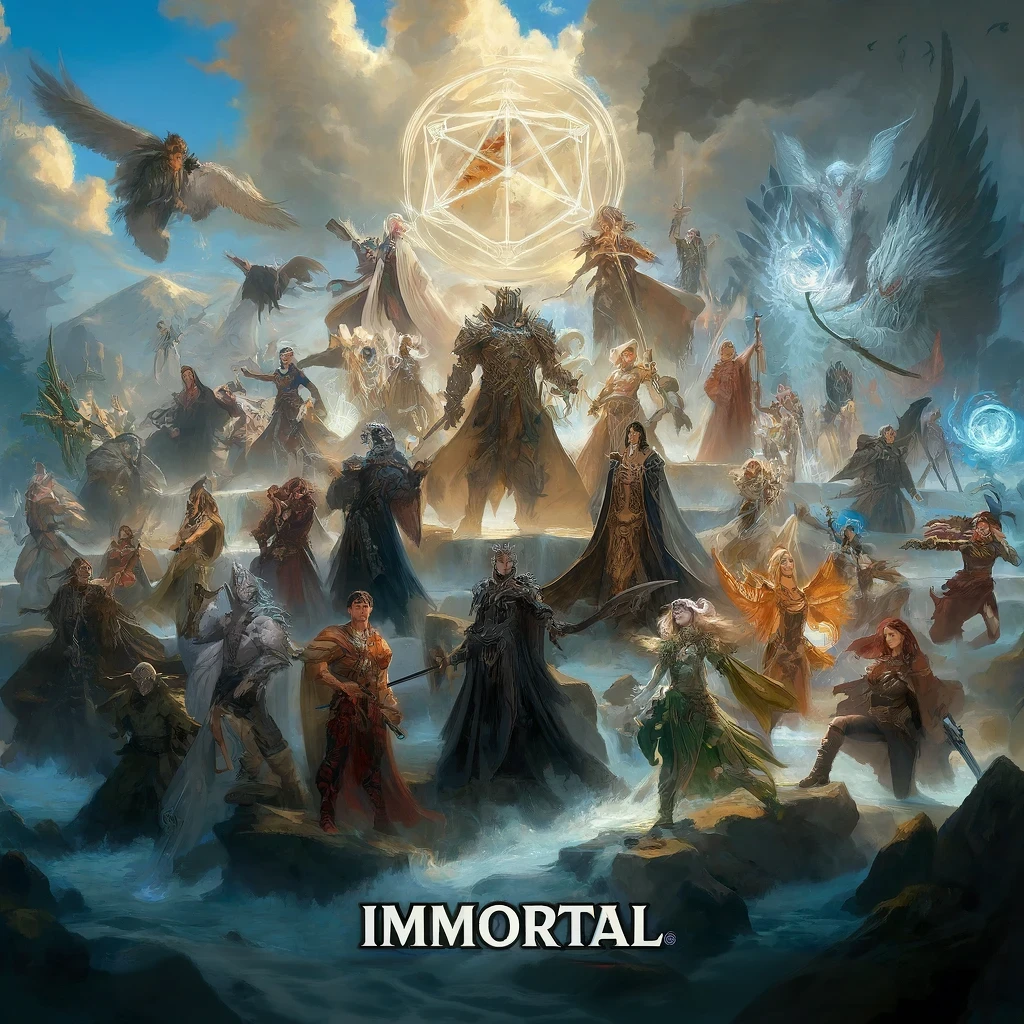
Transition to Immortality
Characters in the Immortal Set undergo a profound transformation, stepping into roles imbued with new powers and responsibilities. This significant change marks a departure from their mortal limitations, introducing a new way of managing experience and abilities. The transition to Immortality is not just a narrative milestone but a comprehensive shift in gameplay mechanics, emphasizing the character's evolution into a being of immense power.
Power Points (PP)
In the realm of Immortals, experience points (XP) are converted into Power Points (PP), the essential currency for Immortal-level actions. This conversion reflects the character's growth and serves as a reservoir of power that can be spent on enhancing abilities, casting potent spells, executing advanced combat maneuvers, and performing other extraordinary actions unique to Immortals. The management and expenditure of PP become central to the gameplay, driving the Immortal's pursuit of even greater power and influence.
Forms and Abilities
Immortals possess the remarkable ability to change forms, adopting both incorporeal and various physical manifestations. This versatility allows them to navigate different challenges with ease, utilizing enhanced abilities and senses that far surpass those of mortals. Whether taking on a form designed for combat, exploration, or social interaction, Immortals are equipped with a range of capabilities that make them formidable entities in any scenario.
Combat Mechanics
The combat mechanics for Immortals introduce new dimensions of engagement. Immortal characters can utilize Aura attacks to influence or terrify mortals, and employ Power-based abilities that can alter the course of battles. With unique defenses and the capability to engage in multi-planar combat, Immortal characters transform the battlefield into a complex arena where their superior skills and strategies can be fully unleashed.
Spheres of Power
Each Immortal aligns with one of the five Spheres of Power-Matter, Energy, Time, Thought, or Entropy. This alignment shapes their abilities and interactions within the multiverse, reflecting their philosophical and elemental affinities. Serving a specific Sphere influences not only their powers but also their roles and objectives in the cosmic order, adding depth and direction to their adventures and interactions with other beings.

Applying to Different Systems
D&D 5e
In Dungeons & Dragons 5e, the transition to Immortality can be achieved by converting experience points (XP) to Power Points (PP), using a ratio that aligns with the game's milestone or level thresholds. This ensures a smooth integration with the existing progression system. Existing class abilities can serve as a foundation for new Immortal powers, which are significantly scaled up to reflect the character's elevated status. To further enhance gameplay, introduce new feats or class features that represent Immortal abilities, such as the capacity for multi-planar travel or the ability to project powerful auras that influence the environment and its inhabitants.
Pathfinder 2e
In Pathfinder 2e, the concept of Power Points (PP) can be similarly integrated by converting XP into a new PP system. Leveraging Pathfinder's detailed feat system, you can introduce Immortal feats that bestow extraordinary abilities and transformations, expanding the character's repertoire beyond mortal limitations. Additionally, implement the spheres of power as new class archetypes or domains, providing specific bonuses and abilities that align with the character's chosen Sphere. This adaptation maintains the complexity and richness of Pathfinder's character development while introducing the grandeur of Immortal play.
AD&D and D&D 2e
For AD&D and D&D 2e, adapting the Immortal rules involves converting XP to PP using the detailed level progression tables inherent to these editions. Introduce new spells, magical effects, and combat mechanics that align with the Immortal theme, ensuring that these additions enhance the high-level play mechanics already present in these systems. Immortal abilities should be aligned with existing gameplay to maintain balance while offering new dimensions of power and influence. This approach enriches the classic gameplay experience with the vast potential of Immortal adventures.
Creating Immortal Characters
Character Creation and Transition
To create Immortal characters, allow those who have reached the pinnacle of their mortal abilities to undergo a transformative ritual. This ritual serves as a narrative milestone, during which their accumulated experience points (XP) are converted into Power Points (PP). This process should be framed by a narrative-driven quest or challenge, symbolizing their transition to Immortality. This quest not only tests their abilities but also marks their evolution into beings of immense power and significance within the game world.
New Abilities and Mechanics
Develop a comprehensive list of Immortal powers and abilities that characters can acquire by spending their PP. These abilities should reflect their newfound status and include enhancements far beyond mortal capabilities. Additionally, create rules for multi-planar travel, enabling Immortals to traverse different planes of existence. Introduce unique combat mechanics and interactions that cater specifically to Immortal beings, ensuring these rules enrich the gameplay and provide a sense of grandeur and limitless potential.
Balancing Gameplay
Balancing gameplay for Immortal characters is crucial to maintaining an engaging and challenging experience. Adjust the difficulty of encounters to reflect the characters' enhanced abilities and introduce new challenges that specifically target their weaknesses or vulnerabilities. By tailoring adversaries and obstacles to the unique strengths and weaknesses of Immortal characters, you can ensure that the game remains balanced and exciting. This approach keeps the gameplay dynamic and prevents Immortal characters from becoming overwhelmingly powerful without meaningful opposition.
Example: Immortal Abilities Across RPG Systems
- Aura:
- D&D 5e: A feat that allows Immortals to emanate an aura that charms or terrifies enemies within a certain radius.
- Pathfinder 2e: A class feature that grants an aura with escalating effects based on the character's level.
- AD&D/D&D 2e: A spell-like ability that can be activated to cause awe or fear, requiring saving throws.
- Interplanar Movement:
- D&D 5e: A spell or innate ability allowing instant travel between planes.
- Pathfinder 2e: A ritual or spell that enables planar travel with specific costs in PP.
- AD&D/D&D 2e: An ability akin to the "Plane Shift" spell but more powerful and with fewer limitations.
- Power Points (PP):
- D&D 5e: A separate pool of points used to activate Immortal abilities, regenerated through resting or specific rituals.
- Pathfinder 2e: A resource similar to "Focus Points" but on a grander scale, used for extraordinary feats.
- AD&D/D&D 2e: A pool of points that can be spent on high-level spells, abilities, and transformations.
By carefully adapting these concepts, you can create a seamless and enriching experience for players across various tabletop RPG systems, allowing them to explore the thrilling and expansive world of Immortals.


